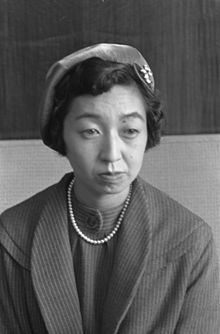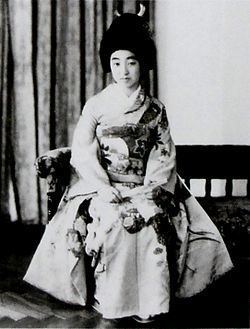Parents Empress Kojun, Hirohito Name Shigeko Higashikuni | Religion Shinto Mother Empress Kojun | |
 | ||
Issue Prince Nobuhiko Higashikuni (東久邇信彦)Princess Fumiko HigashikuniNaohiko HigashikuniHidehiko HigashikuniYuko Higashikuni Died July 23, 1961, Tokyo, Japan Children Nobuhiko Higashikuni, Princess Fumiko Higashikuni, Naohiko Higashikuni, Yuko Higashikuni, Hidehiko Higashikuni Siblings Akihito, Kazuko Takatsukasa, Atsuko Ikeda, Masahito, Prince Hitachi, Takako Shimazu, Sachiko, Princess Hisa Similar People Morihiro Higashikuni, Hirohito, Empress Kojun, Prince Naruhiko Higashikuni, Atsuko Ikeda | ||
Shigeko Higashikuni (東久邇成子, Higashikuni Shigeko, 6 December 1925 – 23 July 1961), born Shigeko, Princess Teru (照宮成子内親王, Teru-no-miya Shigeko Naishinnō), was the wife of Prince Morihiro Higashikuni and eldest daughter of Emperor Shōwa and Empress Kōjun. As such, she was the eldest sister to the present Emperor of Japan, Emperor Akihito.
Contents

Biography
Princess Shigeko was born at Akasaka Palace in Tokyo while her father was still Prince Regent. Her childhood appellation was Teru-no-miya (照宮). As was the practice of the time, she was not raised by her biological parents after the age of three, but by a succession of court ladies at a separate palace built for her and her younger sisters in the Marunouchi district of Tokyo from 1930. Emperor Shōwa opposed the move, but could not defy court tradition. She entered the girls elementary department of the Gakushūin Peer's School in 1932 and completed the secondary department in 1942, learning cooking and literature.
On 9 May 1939, Princess Shigeko rode on the Chōshi Electric Railway Line in Chiba Prefecture from Chōshi to Tōdaimae and back as part of a Gakushūin school outing.
In 1941, she was formally engaged to the eldest son and heir of Prince Naruhiko Higashikuni, Prince Morihiro Higashikuni. The bride and groom were first cousins once removed (since the bride's maternal grandfather and the groom's father were siblings; meaning that the groom was a first cousin of the bride's father). The couple were officially wed in 1943, upon which her official appellation became Shigeko, Princess Morihiro of Higashikuni (盛厚王妃成子内親王, Morihiro Ōhi Shigeko Naishinnō). As the wedding occurred in the middle of World War II, ceremonies and expenses were kept to a minimum, and she wore a junihitoe kimono belonging to her mother, Empress Kōjun, rather than having special clothing created for the occasion.
In August 1947, she and her family were reduced to commoner status with the abolition of titles of nobility by the American occupation forces. With rampant post-war inflation, high taxation, and various failed business ventures by her husband, the Higashikuni family was reduced to poverty. In January 1958, she accepted an offer by the Japanese national television network, NHK, to appear before a live audience and explain the New Year's poetry card reading contest and other royal ceremonies. She fell ill in 1960, complaining of stomach pains, and was diagnosed with cancer. Hospitalized at the Imperial Household Agency Hospital in Tokyo, she died on 23 July 1961. Her grave is at the Toshimagaoka imperial cemetery, in Bunkyo, Tokyo.
Family
Prince and Princess Higashikuni had five children, the last three of whom were born after they were reduced in status to commoners:
- Prince Nobuhiko Higashikuni (東久邇宮 信彦王, Higashikuni-no-miya Nobuhiko ō) (born 10 March 1945); married 1973 Miss Shimada Yoshiko, with one son, Higashikuni Yukihiko (b. 1974)
- Princess Fumiko Higashikuni (文子女王, Fumiko joō, born 23 December 1946); married Mr. Omura Kazutoshi.
- Hidehiko Higashikuni (東久邇 秀彦, born 30 June 1949): adopted by the Mibu family as "Mibu Motohiro"
- Naohiko Higashikuni (東久邇 真彦, born 1953); married to Ms. Sato Kazuko, with two sons, Teruhiko and Mutsuhiko
- Yūko Higashikuni (東久邇 優子, born 1954)
